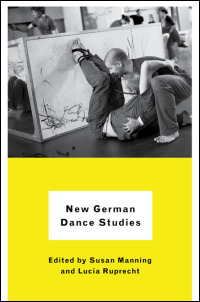 New German Dance Studies contains sixteen essays which range in subject from eighteenth-century theater dance to popular contemporary dances in global circulation. Co-editor Lucia Ruprecht answered our questions about this new collection.
New German Dance Studies contains sixteen essays which range in subject from eighteenth-century theater dance to popular contemporary dances in global circulation. Co-editor Lucia Ruprecht answered our questions about this new collection.
Q: What led to your interest in German dance?
Ruprecht: A general interest in dance combined with an academic position in German Studies.
Q: What distinguishes new German dance from older, more traditional styles of German dance?
Dance in Germany comprises such a range of productions and performative practices that it would be impossible to draw overarching distinctions between the field and less recent types of dance culture. Audiences can watch world-class ballet, but also dance theatre, conceptual contemporary dance, and various kinds of performance art that cross over the boundaries of dance, opera, physical theatre, and visual art. What New German Dance Studies shows are distinctions and continuities, exploring historical genealogies of dance where older forms are restaged, but also revised and questioned by their newer successors.
Q: What do current dance styles reveal about German culture?
Ruprecht: Referring to an example of conceptual contemporary dance, a lecture performance by Xavier Le Roy entitled Product of Circumstances, our contributor Maaike Bleeker has answered this question as follows: “Product of Circumstances also illustrates what might be the ‘Germanness’ of dance in Germany in the early 21st century. Lecture performances as they emerge from within the avant-garde dance scene in Germany at the beginning of the 21st century are exemplary of a situation in which German dance has become a highly international undertaking and in which the ‘Germanness’ (if something like that is to exist at all) of dance in Germany is not a matter of the nationality of the artists involved (their being German), nor necessarily of the place where a particular work was first performed, but rather of Germany being the geographical location of the circumstances of which (to speak with Le Roy again) something that might be considered German dance is the product. In the early 21st century, Germany is a location where performances created elsewhere pass through or are being co-produced with international partners, where festivals draw international audiences, education draws international students as well as teachers, and dance conferences and symposia bring together international experts with international audiences.’ Dance in Germany today bears the hallmark of an era of global fluctuation.”
Q: What type of dance is illustrated on the cover of the book?
Ruprecht: The cover photograph shows a scene from William Forsythe’s Human Writes, a piece that combines the conceptual trend with a virtuosic type of contemporary movement technique.
Q: What was the inspiration for the book?
Ruprecht: New German Dance Studies emerged from our sense that the last decade has witnessed such a rich outpouring of scholarship on dance in German-speaking Europe that a collection was warranted.
Q: Do you have a favorite type of German dance?
Ruprecht: No.
